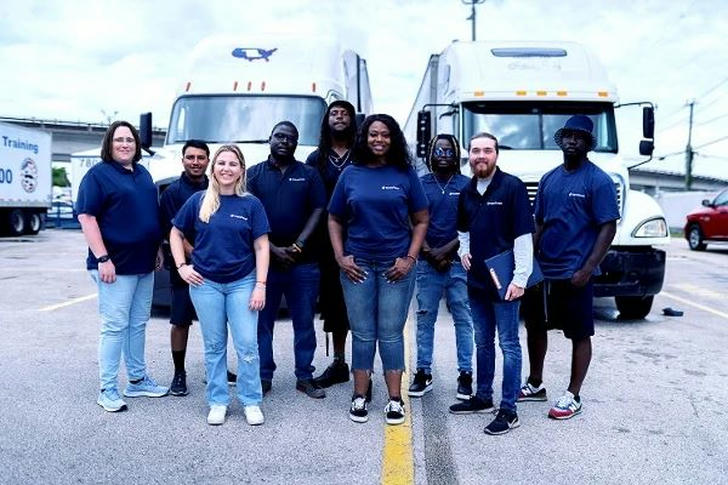Start Your CDL Career: Training and Job Placement Assistance Included
Want to start a rewarding career in the trucking industry? Getting a commercial driver's license (CDL) is the first step, and with no-cost training options available, it's easier than ever to get started.
In this article, we'll walk you through everything you need to know - from understanding CDL requirements to finding no-cost training programs - to help you pave the way for a stable, high-paying career in the trucking industry.

What is a CDL
A CDL, or Commercial Driver's License, is a specialized license required in the United States to operate vehicles that are large, heavy, or carry hazardous materials.
With a CDL, a wide range of career opportunities open up in the trucking industry. Many positions, from long-haul trucking to local deliveries, require a CDL. Driving large vehicles, such as semi-trucks, buses, and tank trucks, also requires a CDL, which is the foundation for building a successful career in the industry.
What to expect during CDL training
1. Classroom instruction
Duration: Typically 40-80 hours. Content: Classroom training covers the basic knowledge needed to pass the CDL written test and safely operate a commercial vehicle.
2. Practical Driving Training
Duration: Typically 30-40 hours of driving practice.
3. On-road Driving Test Preparation
Instructors provide feedback to ensure students are prepared to take the official CDL test.
4. Career Support and Job Placement Assistance
Many CDL schools offer job placement services to help graduates connect with employers. Some schools offer networking opportunities, mock interviews, and partnerships with trucking companies that are actively seeking drivers.
5. Graduation and Exam Scheduling
Once you complete your training, the school will typically assist in scheduling a CDL skills test with the DMV. The school will provide a graduation certificate, which is very useful when applying for a job.
CDL Training Course Prices
1. Average Cost by Program Type
Private CDL Schools: Full training courses cost between $3,000 and $8,000. These schools typically provide in-depth training and job placement assistance. Community College: $1,500 to $3,000. Cheaper, but specifics may vary by state. Online CDL Courses: $0 to $500 for online theory courses (practical training is still required to get a license).
2. Additional Costs
Permit Fees: $50 to $100 for a Commercial Learner's Permit (CLP). CDL Test Fees: $50 to $200, depending on the state. Endorsement Fees: $10 to $100, depending on the endorsement type. Drug Tests and Physicals: Physical exams cost $50 to $150. Study Materials: $10 to $100, but many practice tests are low- or even zero-cost.
Low-Cost CDL Training Options
1. Company-Sponsored CDL Training Programs
Application channels https://bwiny.org/red-hook-on-the-road/apply/
Many trucking companies offer CDL training programs. In exchange, you typically agree to work for the company for a set period of time, usually one to two years. If you leave early, you may have to repay some or all of the training costs.
Popular Companies Offering CDL Training: Companies like Swift, Schneider, CRST, and Prime Inc. offer sponsored training programs with the promise of a job.
Benefits: No upfront costs, hands-on training, and often a job guarantee after training.
2. State and Local Workforce Development Programs
Application channels https://www.crosspurpose.org/career-tracks/cdl-a
Many states provide funding for job training, including CDL training, through workforce development programs. These programs are designed to help people break into popular industries like trucking.
Where to Apply: Check with your state Department of Labor or local workforce development office to find eligible programs. Benefits: Some or all of the costs may be covered, and no employment contract is required.
3. Community Colleges and Technical Schools
Application channels https://cdlschool.com/
Some community colleges and technical schools offer CDL courses at a lower cost. Some institutions may also accept federal financial aid, making these programs even more affordable.
Financial Aid Options: Some programs are eligible for Pell Grants or scholarships, further reducing costs. Advantages: Often more affordable than private schools; may apply for financial aid.
4. Veteran Benefits and the GI Bill.
Application channels https://driverresourcecenter.com/veterans/
If you are a veteran, the GI Bill may cover the cost of CDL training. Many CDL schools accept VA benefits to help veterans get started in a truck driving career.
Where to Apply: Look for a CDL program approved for VA benefits. Many private truck driving schools and community colleges qualify. Benefits: Full or partial insurance coverage without a company commitment.
5. Federal and State Grants or Scholarships
Application channels https://www.fmcsa.dot.gov/grants
Grants such as the Workforce Innovation and Opportunity Act (WIOA) provide funding for career training programs, including CDL training. Some states also offer scholarships specifically for individuals entering in-demand fields.
Where to Apply: State Department of Labor websites, career centers, or the CDL school itself, which may have information about available grants. Benefits: Reduced or waived costs; no job commitment required.
6. Online CDL Theory Training
CDL Career Now https://cdlcareernow.com/
While online training can’t replace hands-on experience, these resources can help you pass your written CDL permit test. Many websites offer CDL practice exams, study guides, and video tutorials.
Where to find resources: Websites like CDL Career Now, Trucker Country, and state DMV websites offer practice tests and study materials. Benefit: Prepares you for your permit exam.
7. Crowdfunding or community support
Learn more https://www.transportation.gov/
If traditional funding sources aren’t available, you can try crowdfunding to raise money for CDL training. Sharing your story and career goals may encourage friends, family, and community members to contribute.
Where to start: Use platforms like GoFundMe and social media to share your campaign. Benefit: Provides flexible funding for those who need financial help.
